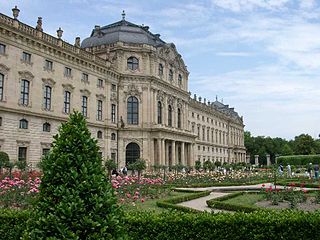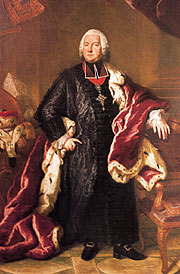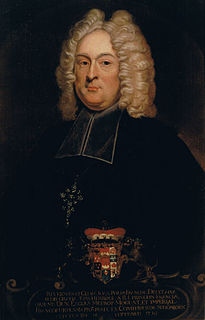
The Würzburg Residence is a palace in Würzburg, Germany. Johann Lukas von Hildebrandt and Maximilian von Welsch, representatives of the Austrian/South German Baroque style, were involved in the construction, as well as Robert de Cotte and Germain Boffrand, who were followers of the French Style. Balthasar Neumann, court architect of the Bishop of Würzburg, was the principal architect of the Residence, which was commissioned by the Prince-Bishop of Würzburg Johann Philipp Franz von Schönborn and his brother Friedrich Carl von Schönborn in 1720, and completed in 1744. The Venetian painter Giovanni Battista Tiepolo, assisted by his son, Domenico, painted frescoes in the building.

The Prince-Bishopric of Würzburg was an ecclesiastical principality of the Holy Roman Empire located in Lower Franconia west of the Prince-Bishopric of Bamberg. Würzburg had been a diocese since 743. As definitely established by the Concordat of 1448, bishops in Germany were chosen by the canons of the cathedral chapter and their election was later confirmed by the pope. Following a common practice in Germany, the prince-bishops of Würzburg were frequently elected to other ecclesiastical principalities as well. The last few prince-bishops resided at the Würzburg Residence, which is one of the grandest baroque palaces in Europe.

The Schönborn family is a noble and mediatised formerly sovereign family of the former Holy Roman Empire.

Johann Philipp von Schönborn was the Archbishop-Elector of Mainz (1647–1673), the Bishop of Würzburg (1642–1673), and the Bishop of Worms (1663–1673).

Lothar Franz von Schönborn-Buchheim was the Archbishop-Elector of Mainz from 1694 to 1729 and the Bishop of Bamberg from 1693 to 1729. As Archbishop of Mainz, he was also Archchancellor of the Holy Roman Empire. Lothar Franz von Schönborn is known for commissioning a number of Baroque buildings, such as the palace Schloss Weissenstein.
Johann Maximilian von Welsch was a German architect, construction director and fortress master builder.
Anselm Franz Freiherr von Ritter zu Groenesteyn (1692–1765) was a Chamberlain of Electoral Mainz, privy counsellor, Majordomo, temporarily Vitztum (vicegerent), High Director of Building and exceptionally gifted architect. His grandfather Stefan von Ritter zu Groenesteyn was of Dutch origin.

Schloss Weißenstein is a Schloss or palatial residence in Pommersfelden, Bavaria, southern Germany. It was designed for Lothar Franz von Schönborn, Prince-Bishop of Bamberg and Archbishop of Mainz, to designs by Johann Dientzenhofer and Johann Lukas von Hildebrandt. Weißenstein, built as a private summer residence, remains in the Schönborn family. It is considered a masterwork of Baroque art.

The Diocese of Würzburg is a diocese of Catholic Church in Germany. The diocese is located in Lower Franconia, around the city of Würzburg, and the bishop is seated at Würzburg Cathedral. Founded in 741, the diocese lost all temporal power after the Napoleonic wars.

Würzburg Cathedral is a Roman Catholic cathedral in Würzburg in Bavaria, Germany, dedicated to Saint Kilian. It is the seat of the Bishop of Würzburg and has served as the burial place for the Prince-Bishops of Würzburg for hundreds of years. With an overall length of 103 metres, it is reckoned to be the fourth largest Romanesque church building in Germany, and a masterpiece of German architecture from the Salian period. Notable later additions include work by Tilman Riemenschneider and Balthasar Neumann. The cathedral was heavily damaged by British bombs in March 1945 but rebuilt post-World War II.

Anselm Franz von Ingelheim was Archbishop-Elector of Mainz from 1679 until his death in 1695.
Anselm Franz von Ingelheim may refer to:

Adam Friedrich Graf von Seinsheim (1708–1779) was the Prince-Bishop of Würzburg from 1755 to 1779 and Prince-Bishop of Bamberg from 1757 to 1779.

Karl Philipp Freiherr von Greiffenclau zu Vollraths was the Prince-Bishop of Würzburg from 1749 to 1754.

The Marienkirche, Würzburg is a chapel located in the inner court of Marienberg Fortress in Würzburg, Bavaria. The first Christian church at this location was built in 706 by Duke Hedan II. The structure of today's building can be traced back to the early 11th century. It is the oldest church in Würzburg and the oldest building in the fortress.

Franz Erwein, Count of Schönborn-Wiesentheid was a German art collector and politician from the House of Schönborn.















